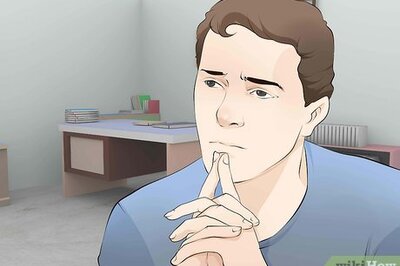
views
TOKYO: Japans economy shrank at a record, even worse rate in the April-June quarter than initially estimated.
The Cabinet Office said Tuesday Japans seasonally adjusted real gross domestic product contracted at an annualized rate of 28.1%, worse than the 27.8% figure given last month.
The coronavirus pandemic, which has people staying home, restaurants and stores empty or closing, and travel and tourism nose-diving, has hurt all the worlds economies and many companies. But it has slammed Japans export-reliant economy.
Restoring growth will be a priority as the country prepares to choose a new leader to replace Prime Minister Shinzo Abe, who is resigning for health reasons. A vote among governing party members is expected next week.
Other data released Tuesday showed cash earnings improving somewhat, and consumer spending and other business activity is expected to rebound following the sharp drops as the country sought to bring the coronavirus pandemic under control.
However, high-frequency data show that growth is struggling to gain pace, suggesting a very gradual and protracted recovery after the initial bounce. The near-term outlook therefore remains challenging,” Oxford Economics said in a commentary.
Quarter-on-quarter, the economy contracted 7.9%, according to the revised figures, down from 7.8% in the preliminary data.
The annual rate shows what the number would have been if continued for a year.
The Cabinet Office said the government began keeping comparable records in 1980. The previous worst contraction, a 17.8% drop, was in the first quarter of 2009 during the global financial crisis. But anecdotally the latest drop is considered the worst since World War II.
Japan had already slipped into recession in the first quarter of this year, contracting by an annualized 2.3%. It shrank 7.0% in the final quarter of last year. Recession is generally defined as two consecutive quarters of contraction. Growth was flat in July-September of last year.
Domestic demand contracted even worse in this years second quarter, as private investment fell. Public demand, driven by government spending, also fared worse than thought earlier.
Abe has centered his Abenomics policies around keeping the economy going through super-easy lending and deregulation. The approach relied mostly on monetary easing by the central bank and helped to end years of deflation. But it never attained the sustained growth rates Abe had targeted.
All of the candidates to replace him are expected to keep most of those policies in place.
___
Yuri Kageyama is on Twitter https://twitter.com/yurikageyama
Disclaimer: This post has been auto-published from an agency feed without any modifications to the text and has not been reviewed by an editor




















Comments
0 comment